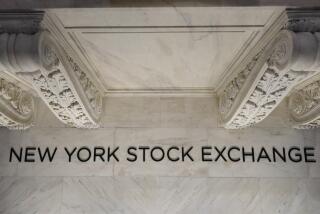What Worked in ’98 Was Then--It’s Time to Start Thinking About Now
- Share via
The first quarter of 1999 seemed all too familiar. Or did it?
Once again, large growth stocks kept growing larger in the first three months of the year. The average large growth stock mutual fund surged 8% during the first quarter, according to Chicago fund tracker Morningstar. And some red-hot funds, like Claire Young’s Janus Olympus, did much better. Olympus turned $10,000 into $12,340 in just 61 trading days.
At the same time, value stocks--shares of beaten-down or overlooked companies--kept losing value. Small stocks kept getting smaller. And foreign stocks were a mixed bag.
But look beneath the static numbers and you may notice something interesting.
Although there’s still a big gulf between the performance of large growth funds and large value funds, it’s not nearly as wide as the 10-percentage-point gap in the fourth quarter of 1998.
More important, as long-term interest rates and oil prices began to rise in February, investors refocused their attention on value. To be sure, it was not at the expense of blue-chip growth stocks. Still, in the last two months of the quarter, value investing was on equal footing with growth.
The numbers tell the story. While the Standard & Poor’s 500/Barra Growth index trounced the S&P; 500/Barra Value index 6.9% to 2.6% in the first quarter, from Feb. 2 to March 31 the two indexes were virtually tied. Growth stocks returned 2.2% during that two-month period while value returned 2.1%.
There’s more. Take a look at what happened to foreign stocks.
In recent years, as long as you steered clear of Asia, Latin America and other emerging markets and plowed most of your cash into developed Europe, you were fine.
That was certainly the winning formula for Harbor International Growth, Vanguard International Growth, GAM International, Brinson Global (Ex. U.S.) Equity and countless other four- and five-star Morningstar-rated foreign funds that recently held more than 70% of their assets in Europe.
But in the first three months of this year, this strategy fell apart. All four lost money during the quarter--as did the average stock fund that invests primarily in European stocks, which was down 3.3% for the quarter.
At the same time, stocks in emerging markets, which most of us declared all but dead, rose from their sickbeds during the quarter. The typical Latin American stock fund is up 11.3% so far this year, while the average diversified emerging-markets fund is ahead 7.7%.
“Is this the beginning?” asked Clark Blackman, national director of investment advisory development for Deloitte & Touche in Houston. “It could be,” he said. “I don’t think anyone today would be surprised by a flip in what’s in favor.”
Even if a real change in market leadership is still months away, the first-quarter numbers remind us how foolish--and dangerous--it is to assume that certain stocks (or stock funds) will be leaders indefinitely.
“It’s shortsighted to believe that the best place to be today is the same best place to be 10 years from now,” Blackman said. “Remember at the end of the 1970s, you couldn’t find a person who didn’t believe that the place to be was in real estate and oil and gas. In retrospect, that’s pretty funny.”
It all boils down to the basic concept of “reversion to the mean.” Given enough time, things eventually go back to normal.
What does “normal” mean? It means you shouldn’t expect large growth stocks to be slam-dunk investments going forward.
Remember: It’s one thing to see your money-losing small-company stock fund lose another 30% of its depleted value. It would be far more painful to see your large-growth-stock fund, with all the gains of the recent bull market, lose a third of its hyper-inflated value.
“The second-worst thing that can happen to a novice investor is that he loses all his money upfront,” said Greg Schultz, principal with Asset Allocation Advisors in Walnut Creek, Calif.
“The worst thing,” Schultz added, “is that he makes money upfront, digs into his pockets and puts everything into those same winning investments and then loses it all.”
READY FOR A CHECKUP?
READY FOR A CHECKUP? The Times’ first-quarter investment report will appear Tuesday as a separate section, with strategies, lists of top-rated mutual funds and special stories focusing on 401(k) accounts.
Do you have ideas for mutual fund and 401(k) topics for this column? Times staff writer Paul J. Lim can be reached at paul.lim@latimes.com.
More to Read
Inside the business of entertainment
The Wide Shot brings you news, analysis and insights on everything from streaming wars to production — and what it all means for the future.
You may occasionally receive promotional content from the Los Angeles Times.










